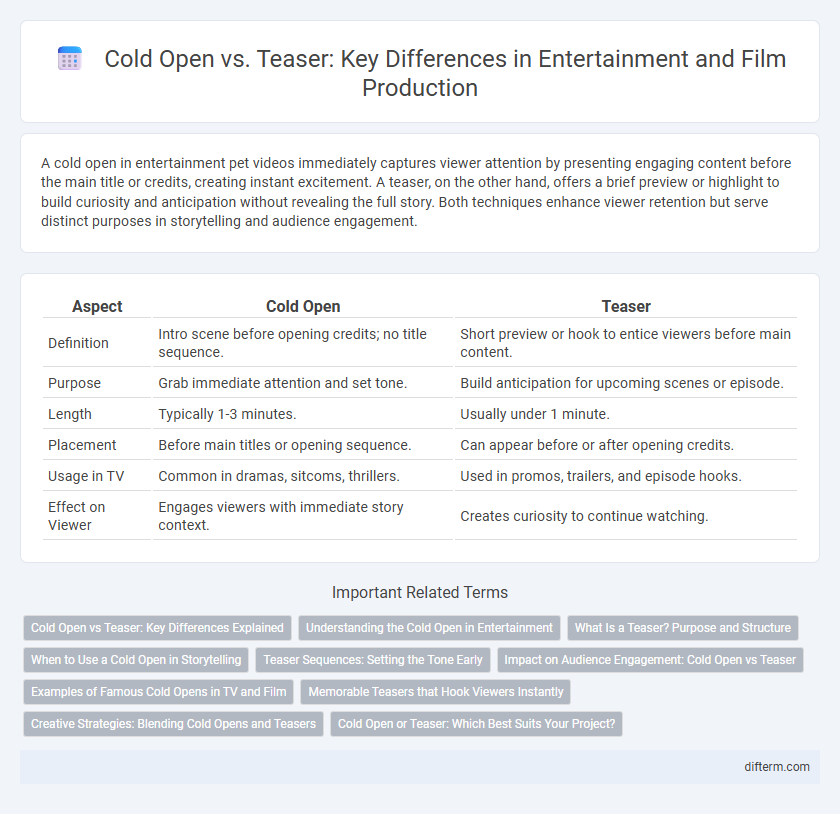A cold open in entertainment pet videos immediately captures viewer attention by presenting engaging content before the main title or credits, creating instant excitement. A teaser, on the other hand, offers a brief preview or highlight to build curiosity and anticipation without revealing the full story. Both techniques enhance viewer retention but serve distinct purposes in storytelling and audience engagement.
Table of Comparison
| Aspect | Cold Open | Teaser |
|---|---|---|
| Definition | Intro scene before opening credits; no title sequence. | Short preview or hook to entice viewers before main content. |
| Purpose | Grab immediate attention and set tone. | Build anticipation for upcoming scenes or episode. |
| Length | Typically 1-3 minutes. | Usually under 1 minute. |
| Placement | Before main titles or opening sequence. | Can appear before or after opening credits. |
| Usage in TV | Common in dramas, sitcoms, thrillers. | Used in promos, trailers, and episode hooks. |
| Effect on Viewer | Engages viewers with immediate story context. | Creates curiosity to continue watching. |
Cold Open vs Teaser: Key Differences Explained
A cold open starts a show or episode immediately with a scene before the opening credits, designed to grab the audience's attention quickly, while a teaser serves as a brief preview or hook that introduces the episode's theme or conflict. Cold opens immerse viewers directly into the story, often presenting a mystery or cliffhanger, whereas teasers build anticipation by hinting at upcoming events without revealing plot details. Understanding these distinctions highlights how cold opens heighten immediate engagement, and teasers sustain viewer interest throughout a program.
Understanding the Cold Open in Entertainment
The cold open is a storytelling device that begins a show with an attention-grabbing scene before the opening credits, designed to hook viewers immediately. Unlike a teaser, which often previews upcoming content, the cold open immerses the audience directly into the narrative or a pivotal moment, enhancing engagement from the outset. This technique is widely used in television series, especially in comedies and dramas, to establish tone and build suspense without delay.
What Is a Teaser? Purpose and Structure
A teaser in entertainment serves as a brief, engaging segment designed to hook viewers before the main content begins, often showcasing a suspenseful or intriguing moment without revealing key plot details. Its purpose is to build curiosity and anticipation, encouraging audiences to continue watching by providing a tantalizing glimpse of the storyline or characters. Structurally, a teaser typically lasts one to three minutes, setting the tone and mood while withholding full narrative context to maximize intrigue.
When to Use a Cold Open in Storytelling
A cold open is ideal in storytelling when the goal is to immediately captivate the audience by dropping them directly into an intense or intriguing moment before the main titles. This technique builds suspense, creates curiosity, and establishes tone without the need for prior exposition. Cold opens work best in genres like thrillers, dramas, or sitcoms where grabbing attention at the outset can enhance viewer engagement.
Teaser Sequences: Setting the Tone Early
Teaser sequences establish the tone early by immersing viewers in the story's mood and themes before the main episode begins, often using suspense or intrigue to capture attention. Unlike cold opens, which may serve as standalone mini-scenes or unrelated moments, teasers are tightly integrated with the episode's narrative arc. This strategic use of teaser sequences enhances audience engagement and sets clear expectations for the unfolding plot.
Impact on Audience Engagement: Cold Open vs Teaser
Cold opens immediately immerse viewers by presenting a dramatic or suspenseful scene before the opening credits, significantly boosting initial audience engagement and curiosity. Teasers, often shorter and strategically placed after the credits, serve to hook the audience by introducing key plot elements or cliffhangers. Both techniques leverage emotional and narrative hooks but differ in timing and structural impact on viewer retention and anticipation.
Examples of Famous Cold Opens in TV and Film
Famous cold opens like "Breaking Bad's" intense flash-forward in the pilot episode immediately grab viewers by showing Walter White's descent into the meth world before any plot buildup. The TV show "The Office" uses cold opens such as the iconic stapler-in-jello prank, setting a comedic tone without context. In film, "Saving Private Ryan" starts with a gripping D-Day landing scene, plunging the audience into action without exposition, exemplifying a powerful cold open.
Memorable Teasers that Hook Viewers Instantly
Memorable teasers captivate audiences by delivering gripping scenes or provocative questions that spark curiosity instantly. Cold opens often place viewers directly into the action, creating an immediate emotional connection without traditional title sequences. These techniques enhance viewer engagement by setting a suspenseful or intriguing tone that encourages continued watching.
Creative Strategies: Blending Cold Opens and Teasers
Cold opens and teasers serve distinct creative strategies in entertainment, with cold opens immediately immersing viewers in action or key plot points to capture attention, while teasers provide suspenseful preview snippets that build anticipation. Blending these elements enhances narrative engagement by opening episodes with intriguing moments followed by brief, thematic glimpses of upcoming content, maintaining viewer interest throughout. Strategic integration of cold opens and teasers can optimize pacing and emotional impact, driving higher audience retention and deeper investment in the storyline.
Cold Open or Teaser: Which Best Suits Your Project?
Cold opens grab immediate attention by dropping viewers into the action before titles or credits, heightening suspense and engagement, while teasers build curiosity with brief previews designed to hook the audience. Choosing between a cold open and a teaser depends on the narrative style and pacing of your project, as cold opens excel in high-energy dramas whereas teasers suit projects aiming to create anticipation. Evaluating your genre and target audience's preferences ensures the opening strategy maximizes impact and viewer retention.
cold open vs teaser Infographic

 difterm.com
difterm.com